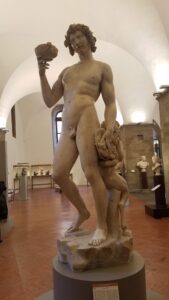On Tuesday, January 21, we continued gaining knowledge, understanding and appreciation of Renaissance art and architecture by going to the Bargello and the Accademia museums in the lovely city of Florence. Both sites are known for their heroic, yet different statues of David created by Michelangelo (at the Accademia) and Donatello (at the Bargello). The biblical story of David is beloved by the culture here as it depicts the values of their society– both in the past and present. In our student lead discussion we communicated our personal favorite sculptures and opinions regarding the comparison of early to late Renaissance sculptors.

We started our discussion by provoking the class with the following question: “We’ve discussed many different paintings in this class, and we were wondering how sculptures create a different experience for viewers.” Sculptures emphasize the movement and expression of a subject, more so than most Renaissance paintings. Sculptures are also more interactive, allowing the audience to witness a three-dimensional view of the work of art. By walking around a sculpture, we are able to study each side of the art. We also discussed the advantages and disadvantages of sculpting as an art form vary depending on what method of sculpting is being used. Typically sculpting is more physically demanding than other art forms such as painting because shaping materials like marble requires the sculptor to hit at the block over and over again. Sculpting also requires more equipment and a larger work space. In terms of advantages, as mentioned earlier, sculptures are three dimensional so they offer many visual advantages. From the perspective of patrons, one disadvantage of sculptors is that they are very expensive, which is why many patrons preferred to commission paintings and frescoes. The advantage of commissioning sculptures, however, is that they can be placed outside of palaces and other buildings so that everyone can see them. For a wealthy patron, this means that they can commission a sculpture to place outside their home so that everyone can see their wealth and power. Michelangelo’s David sculpture, for example, was originally located outside of what is now the Palazzo Vecchio, formerly known as the palace of the Medici family. This allowed the whole town to witness their power and wealth. Paintings and frescoes on the other hand, have to be inside, so only their guests would be able to see them.

Michelangelo was one of the sculptors we focused on in our discussion. Specifically, we talked about how his Bacchus sculpture was different from his other sculptures. Bacchus, the God of wine, is presented as being inebriated. This is the only sculpture of this portrayal that we know of. Typically, Michelangelo’s sculptures portray more of a biblical approach through time, whereas Bacchus is a representation of Pagan faith. As the Renaissance continued, the improvement of facial expressions became prevalent. Bacchus is a great example of these improvements, as it’s very easy to tell that the man in this sculpture is drunk.

Another great artist during this time was Donatello. In his lifetime, he created two different sculptures of David. His first David, created in marble, was a safe depiction of the hero. The face was not very expressive, other than hinting at a stoic emotion. His later David sculpture, however, was bronze-casted, which hadn’t been a very prevalent style since classicalism. This depiction of David was youthful, erotic, and feminine. It seemed to convey David as how the Bible described him; a youthful, heroic, feminine boy.
Because the most important sculptures we saw were Donatello’s David and Michelangelo’s David, we asked the class to choose which David sculpture was their favorite and used their opinions to compare the two sculptures. The people who enjoyed Donatello’s bronze-casted David said they liked how it followed the appearance given in the Bible. They also noted that this sculpture was different than any others we have seen, especially with the feminine portrayal. Others noted that the feminine aspect may have gone too far. On the other hand, Michelangelo’s David was the favorite of many, due to the emphasis on manliness and size. They also liked how it was anatomically correct, proportional, and very expressive. In this portrayal, he is expressed as tense, brave, and ready to kill Goliath, rather than already having killed him. The veins and tensed ligaments in his arms show David as a potential symbol of God being prepared to protect the people of Florence.
Finally, because David is considered to be Florence’s hero, we were curious to see which David best represents past Florence, and which represents present Florence. Many people said that Michelangelo’s David portrays both past and present Florence, due to the strong willpower that is obvious in this statue. Florence was never a small, weak city, therefore the strong, tense David sculpture has always represented Florence well. Others mentioned that Michelangelo’s David only represents past Florence, because of the past tension of the political structure. The people who mentioned this opinion said that present day Florence is shown by Donatello’s bronze-casted David, representing the beauty and art that Florence is known for today.
In conclusion, Renaissance art– specifically in regard to sculptures– changed drastically from the beginning to the end. We can see this transition through the comparison of artwork done by artists at different points in the Renaissance. Each artist had different abilities and visions while creating the pieces mentioned, and the perceptions of viewers must also be considered while making these comparisons. This versatility of opinion makes the field of art truly remarkable.
-Annika Silverberg, Jessie Strobush, & Tessa Westlund
Leave a Reply